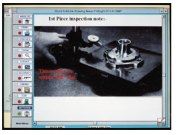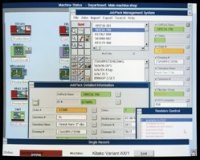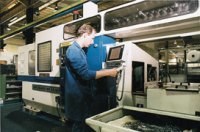Look What's Happened To DNC
Today's DNC systems are doing far more than just moving part programs around. They've evolved into full-blown shop floor information networks.
Share


Hwacheon Machinery America, Inc.
Featured Content
View More





While it's been a protracted and rocky road for numerical control, the latest breakthroughs indicate DNC has truly come of age. Recent developments in software and client/server networking lay to rest the old misconceptions of prohibitive expense, complexity and inefficiency. Instead, they provide a sophisticated, cost-effective technology that is more than living up to early expectations.
The Road To Perfection
The first NC systems were hard-wired circuits connecting the machine tool servo motors to the machine control unit (MCU). After initial developmental bugs were worked out in the 1950s, these early NC machines increased production and made it possible to do the types of jobs that a manual worker could never accomplish—jobs such as forming dies, molding cavities, airfoils and other aircraft components. Then came computer numerical control (CNC) which utilized an on-board computer as the MCU, allowing the machine tool to repeat work from its own memory. The greater output of CNC expanded the new technology into automation of small batch production traditionally done by manual machines. Yet many problems remained, not the least of which was dealing with paper tape programs that continued to be the primary medium for program transfer.
Then came direct numerical control (DNC) which provided the ability to connect machine tools to a common, centrally located computer that stored the part programs and, on demand, distributed the machining data to the different MCUs. Direct NC kept the operator at the machine, bypassing the need for paper tape, and substantially reduced setup time. But one drawback remained; if the computer went down, all its machines were inoperative.
Now there's distributed numerical control, which employs a network of computers to coordinate the operation of multiple machines by feeding a program to the CNC memory where it can remain and function independently. The operator can collect, edit and return the program. This is a significant advantage over direct NC machines which were uni-directional and dependent on a central computer. Thus, the term DNC has come to mean both direct and distributed numerical control, though the later term is more representative of the dominant application in today's modern machine shop.
State-Of-The-Art DNC
State-of-the-art DNC systems today can do much more than just send and receive NC programs. They can transmit part programs in blocks (drip feed), administer sub-programs and allow for re-entry into interrupted programs. In addition, some systems can relay data to third-party systems, offer a surprising level of configurability, and even execute "background processing" where multiple activities are handled simultaneously. Some systems also are equipped with quality control features such as a gage port interfaces and can establish the connection to electronic measuring equipment, displaying "measured data" as a control chart.
The capabilities of DNC have been greatly expanded over the last few years to include more functions that simplify operations. In the past, hardware determined the capability of the system. Nowadays, software innovation leads the way. Here are some of the key features of modern DNC systems:
Editing—It is possible to run one NC program while others are being edited (background processing), providing shop floor people the ability to work with multiple programs at any given moment.
Compare—This takes an edited version of an NC program, compares it to the original and marks the differences in color so that a process engineer can evaluate the changes.
Restart Function—In older equipment, if a tool broke or wore out halfway through a program, the whole program had to be re-run after the tool change, wasting hours of work. Now a program can be stopped, the tool changed, and the program re-started where it left off.
Job Tracking—With some DNC systems, there is no longer a need to clock in jobs at some shop control system terminal far away from an operator's work area. A worker can do it right at his machine, and at the same time record what job is being worked on, how long setups take, and so on.
Video Hook-Up—It is now possible to watch a video on site that demonstrates how to operate and set up a machine, as well as run any specified job.
Diagnostics—Maintenance is made much easier by a system of diagnostic coding that isolates what's wrong with a particular machine, saving hit-and-miss troubleshooting that otherwise could take days.
Displaying Drawings—Photos, graphics and CAD drawings of tools, fixtures and finished parts are readily available in various formats.
Advanced Database Management—Residing on the network server, such software organizes and maintains data, and allows for the retrieval, view and update of information. It provides fast, consistent and predictable response to database queries and report generation.
Touch Screen Interfaces—One touch of the fingertip is all that is needed for the machinist to select the desired function.
Machine Tool Monitoring
Most managers don't find out about downtime until well after the fact, regardless of what computer system they use. Lengthy job setups and unexpected stoppages can go on for hours before word of the downtime makes its way upstairs.
Machine tool monitoring, probably the most significant advance in software to complement DNC, is essentially a means of transforming a complex, unwieldy jumble of information into a smaller database, fully isolated from the main shop floor data. It provides automatic report generation of machine tool utilization, work order status and labor reporting. The system has the ability to collect specified facts and figures from in-process transactions being recorded moment by moment on the shop floor. It enables personnel to analyze data, generate standard and ad hoc reports, as well as to pass information off to MRP II and financial systems.
In the case of DLoG's machine monitoring capability, it makes use of a binary logbook rather than a database. This allows for significantly faster processing. For instance, if the primary database has five million entries and a query involves 500, the "DC Engine" gathers only the data relevant to that query. Since the DNC system doesn't have to deal with thousands of unrelated records, it brings fast, uncomplicated access to the information without costly databases or other types of administrative overheads.
DNC In The Workplace
Pat Collins is a manufacturing engineer for Allied Signal Aerospace in South Bend, Indiana. According to Mr. Collins, his company had an outmoded NC program management system that didn't function properly as a network. He notes, "Our hardware was obsolete, with four or five different centers of control. We had two different types of NC programs running and had to remember to store updates in four or five places manually. If you forgot, you ended up with some machines running on the new version and others on the old."
The solution to this problem was to install a new DNC system that gave timely distribution of information between planning and the shop floor. According to Mr. Collins, this upgrade resulted in a substantial reduction in downtime and increased productivity by fifteen percent. "Part of the plant was storing programs on floppy disks," he says. "Each operator had his own disk, modifying it as he went along. One worker would have a different program than his shift replacement, causing confusion on the machines involved. In other areas, we were using a paper tape punch that took fifteen minutes to load each time. Sometimes it contained reader errors. The readers and punches were aging, causing machine malfunctions and damage.
"Another problem was operators spending too much time on setups. Besides the time it took to download programs, the operators didn't have all the data at their fingertips to get the job done. So it often required trips to the engineering department to get everything straightened out.
"We now have file integrity using one server. The new DNC system takes less than a minute to do what took fifteen in the old sys-tem. With seventy uploads and downloads per day, this is a significant saving."
Brendan Kowalski, Computer Operations Manager at American Mold Technologies in Harrison Township, Michigan, has seen many changes in technology during his fourteen years in the business. At American Mold, Mr. Kowalski was charged among other things to lead the company's investigation and acquisition of the latest DNC technology. He says, "We were a new firm, starting out from scratch, and I was hired to research, install and run the computer network."
That investigation found that DNC technology had indeed made major advances in the last decade. As Mr. Kowalski puts it, "In older systems, you could use no more than 50 feet of wire before you needed a booster. We would have needed 20 booster boxes for our three-quarter mile of networking line. With our new system we use only one. It has a 10-megabit transfer rate, and in four years of operation, we've never lost a bit of data in 30,000 to 40,000 transfers. That's phenomenal.
"We do high speed cutting at 400 inches per minute at 12,000-rpm spindle speeds. A tremendous amount of data is being fed down the lines to keep up with that, but our DNC system handles it excellently."
The Paperless Shop
While the goal of eradicating paper from the workplace has been with us for decades, the achievement of this dream is closer than most people realize. It has been estimated that US corporations spend eleven percent of their gross income on generating, controlling and retrieving paper. In the manufacturing environment, elimination of paper though the introduction of a broadly functioning DNC shop floor network can offer a huge payback. Indeed, installation of a modern DNC system can result in an immediate eighty percent reduction in paper. And it isn't just the direct costs of managing information that can be dramatically reduced. Shops that utilize this technology properly should also see lower costs in NC programming, setup, supervision and even maintenance as well.
Moreover, initial system cost is no longer a significant barrier to building a paperless manufacturing environment. Early DNC equipment was an extremely costly investment, and only the larger firms were able to afford it. But with the price of computers steadily falling, a DNC system is available to most manufacturers at a fraction of the former investment.
The Future of DNC
The future of DNC is headed toward multimedia access via the Internet. A user may simply log onto a DNC server whenever needed and then be charged for the time used. This will make the technology more affordable because users pay only for the time they use the system. That means that the DNC of the future must be Internet enabled and must work on any hardware. DNC providers will have to adapt from handling a few large, expensive orders to servicing millions of customers, each paying a relatively small amount. It's likely that each operator will have his or her own multimedia PC, something that's coming much faster than most people believe. In the meantime, the use of DNC will increase in prototype and small job shops due to the arrival of lower cost controllers containing many of the advanced programming features.
"Another wave of change could involve PCs taking over part of the role of a CNC controller," reports Professor Chao-Hwa Chang, a specialist in NC programming and software at UCLA's Department of Mechanical and Aerospace Engineering. "The cost of current CNC controls is inflated due to patented software, expensive chips and the small numbers produced. PCs could take over the programming and memory functions of a CNC control for a fraction of the cost."
With the bugs that have plagued numerical control over almost half a century, and the perpetual wave of optimism about its potential from its creators and developers, it is hardly surprising that some misconceptions exist about the performance rates of DNC. But one only has to see the latest DNC systems in action to know that this technology has finally come of age. It is no longer the case that DNC needs to develop further to be able to fully handle the needs of the machine shop. With the speed and capabilities of current systems, it is the machines themselves that need upgrading to keep up with the work rate potential of DNC.
Related Content
The Power of Practical Demonstrations and Projects
Practical work has served Bridgerland Technical College both in preparing its current students for manufacturing jobs and in appealing to new generations of potential machinists.
Read MoreGenerating a Digital Twin in the CNC
New control technology captures critical data about a machining process and uses it to create a 3D graphical representation of the finished workpiece. This new type of digital twin helps relate machining results to machine performance, leading to better decisions on the shop floor.
Read MoreAutomated CAM Programming – Is Your Software Really Delivering?
A look at the latest automation tools in Autodesk Fusion 360 software and how forward-thinking machine shops and manufacturing departments are using them to slash delivery times and win more business.
Read More6 Machine Shop Essentials to Stay Competitive
If you want to streamline production and be competitive in the industry, you will need far more than a standard three-axis CNC mill or two-axis CNC lathe and a few measuring tools.
Read MoreRead Next
Registration Now Open for the Precision Machining Technology Show (PMTS) 2025
The precision machining industry’s premier event returns to Cleveland, OH, April 1-3.
Read MoreBuilding Out a Foundation for Student Machinists
Autodesk and Haas have teamed up to produce an introductory course for students that covers the basics of CAD, CAM and CNC while providing them with a portfolio part.
Read More5 Rules of Thumb for Buying CNC Machine Tools
Use these tips to carefully plan your machine tool purchases and to avoid regretting your decision later.
Read More













































.jpg;maxWidth=300;quality=90)









